Along with Denton, Collin County has quickly become one of the trendiest places to live in Texas. While it was originally seen as a rural county, Collin is rapidly becoming established as DFW’s premier suburb. This demand has increased property values and the corresponding taxes for both businesses and homeowners. 2025 saw this upward trend continue unabated, making Collin one of the most expensive places to own property in Texas. With residential values up 4.9% and commercial property going even higher at 14.8%, more people than ever are turning to property tax protests to turn the tide.
Property owners in Collin County have learned to use the right to protest like few others, and over 26% of all property is appealed each year. With this in mind, we will see how the first round of appeals fared and why it is so important to stand up for your rights. It should be noted that Collin County leans heavier on the Appraisal Review Board (ARB) as the decider, rather than informal appeals. The numbers in this article are mainly from informal appeals, as ARB hearings are currently ongoing and will take months to shake out.
Collin COunty Informal Appeals Help Defend Homes
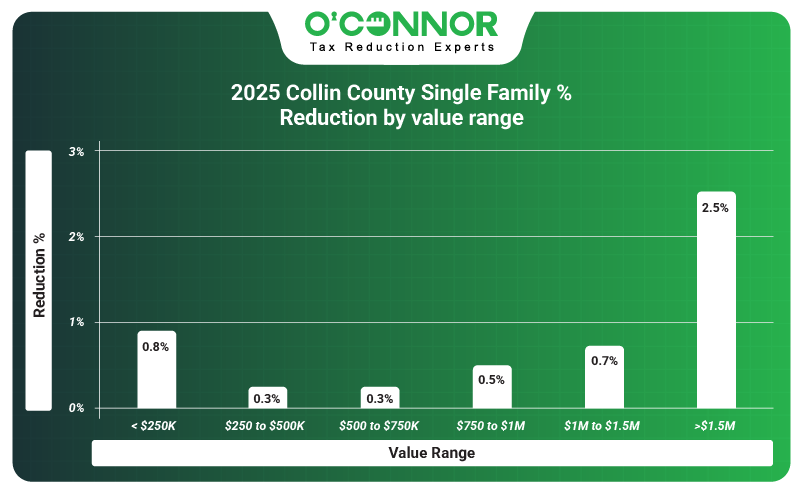
Informal appeals are the first step in the quest to lower taxes and must be filed before an ARB hearing can be tried. As most cases push toward the ARB, some will take settlements offered by the Collin Central Appraisal District (CCAD). These appeals and settlements were able to reduce residential taxable value by 0.6%. CCAD initially set the value of single family homes at $196.17 billion, but this number has been lowered to $195.01 billion thanks to appeals. Homes worth between $250,000 and $500,000 and those worth $500,000 to $750,000 are the two most valuable categories, and each was reduced by 0.3%. High-dollar homes got the largest cut according to percentage, getting back 2.5% in taxable value.
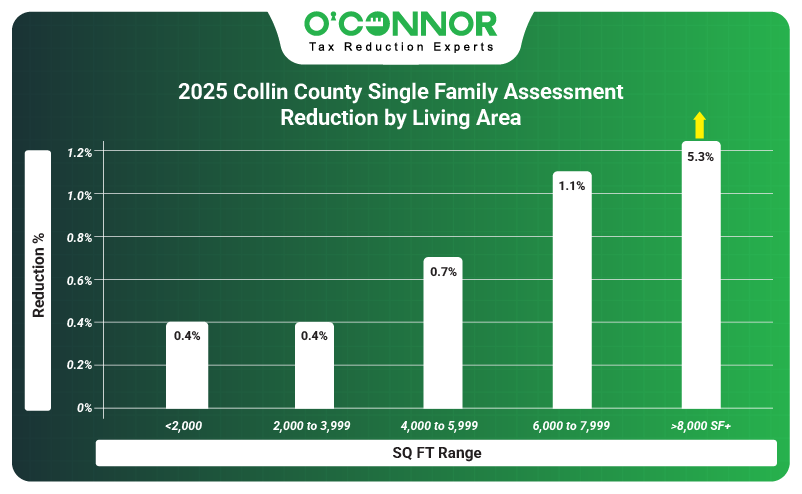
Residential value in Collin County is heavily weighted towards homes that are between 2,000 and 3,999 square feet. These homes make up $120.36 billion of the total. These homes had been hit by a 4.4% increase in 2025 and were able to claw back 0.4% thanks to early appeals. The No. 2 category of homes, those sized from 4,000 square feet to 5,999 square feet, did a bit better with 0.7%. The largest of homes saw a 2025 value increase of 21.5% and managed to score a reduction of 5.3%. The smallest of homes managed a reduction of 0.4% as well. Property tax protests are a universal tool, no matter the size of a property.
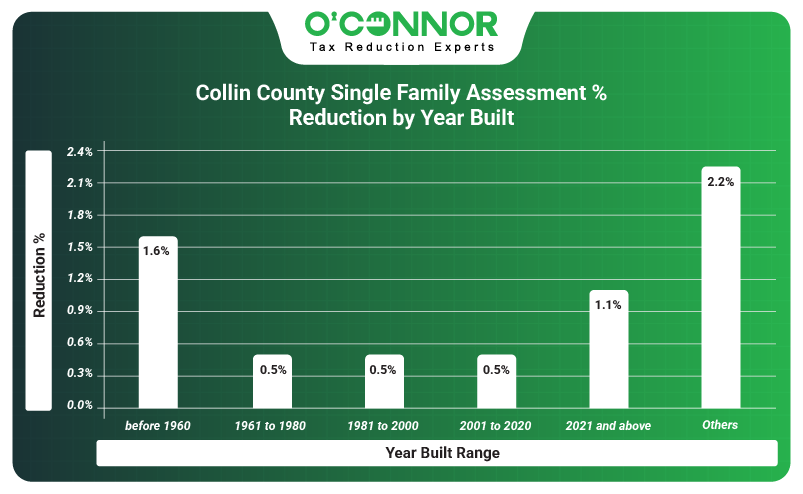
Collin County is a true boom area, with 61% of all residential property value being built between 2001 and present day, including 14% from new construction. New construction added $6.12 billion in taxable value, according to CCAD, an increase of 30.5%. Informal appeals were able to get a value reduction of 1.1% for these homes, a drop in the bucket, but a key step. Homes built between 2001 and 2020 achieved savings by 0.5%, compared to a previous rise of 1.2%. While a tiny fraction of the whole, the oldest homes managed to cut 1.6% from the value spike.
Commercial Protests Slash Surge Values Nearly in Half
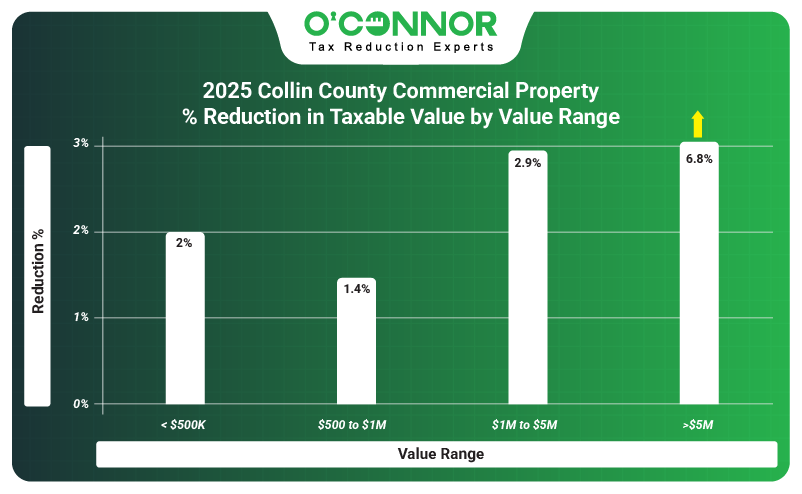
While Collin County has a reputation for expensive residential property, it was commercial interests that got hit by CCAD’s hammer in 2025. Taxable values for business properties shot up by 14.8%, going from $57.59 billion to $66.09 billion. $54.57 billion came from commercial properties worth over $5 million, which saw a jump of 15%. Informal appeals sit back with precision; however, and the first wave of appeals alone managed to score a total reduction of 6.1%. This includes 6.8% for the top businesses and led to a grand total savings for all commercial properties that added up to $4.32 billion. As businesses are tailor-made for ARB hearings, the savings are bound to double or more in the coming months.

The main target for both CCAD and appellants were apartments. A mix of residential and commercial, these multifamily behemoths represented $25.27 billion in 2025, before being slashed by 8.3% thanks to initial appeals. Offices, the next on the value chart, were able to reduce their own gaudy numbers by 4.4%. Hotels saw their value jump off the chart with a 40.5% increase but got a splash of cold water with 13.4% in reductions. Retail and warehouses achieved savings of 4.9% and 3.6% against jumps of 15.4% and 26.6% respectively.
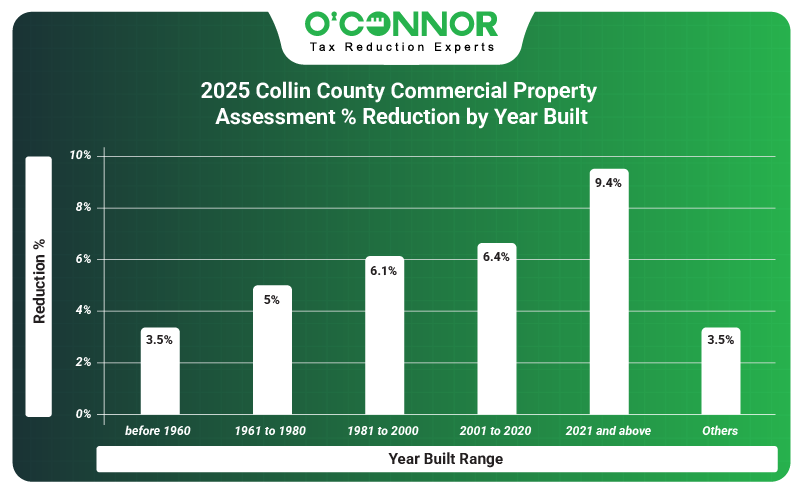
Commercial property in Collin County follows the pattern set by homes when it comes to the age of construction. 45% of all value was built during the period from 2001 to 2020, while new construction contributed 9%. In addition, 23% was built between 1981 and 2000. New construction saw a 64.6% increase in taxable value, though this was stymied somewhat by a protest reduction of 9.4%. Commercial properties built between 2000 and 2020 saw an increase of 9.7%, but this was countered by an appeal reduction of 6.4%. Commercial properties that were constructed from 1981 to 2000 are the second-largest category, and that is before receiving an increase of 9.5%, which was balanced by a reduction of 6.1%.
Collin County Apartment Assessed Value Reduced by 8.3%
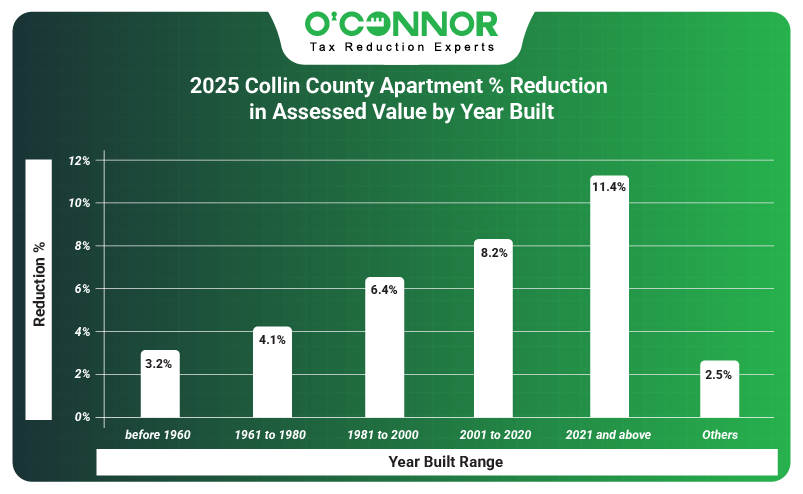
Apartments are consistently the top commercial property in Texas and Collin County is no different. As a suburb of DFW, housing is at a premium, as we have already seen with home prices. Things got jacked up even further in 2025, as the 16.5% value increase would cause issues for owners and renters alike. Thanks to aggressive protesting, these inflated values have been cut by 8.3%. Like everything else in Collin County, half of all apartment value was built in the boom period from 2001 to 2020, and these apartments getting a reduction of 8.2% had an outsized impact on the total. New construction likewise got a strong 11.4% slashing, contributing to the assessed value jump of 79.3%.
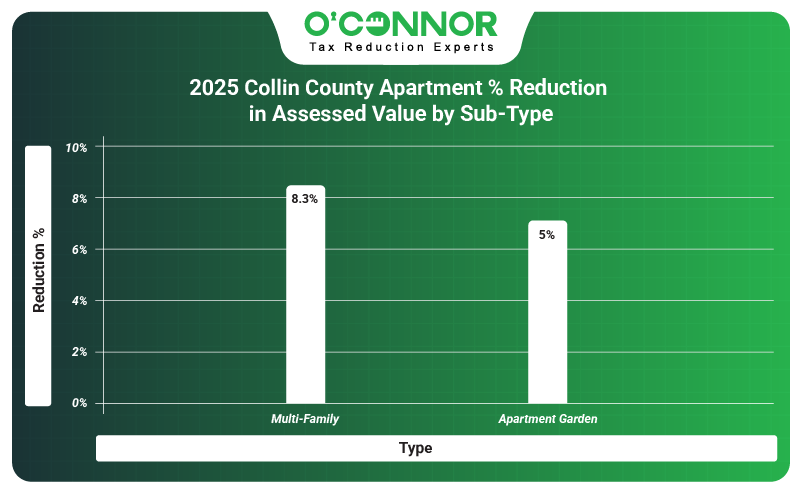
CCAD only breaks down apartments into two subtypes, limiting the information that can be gathered. The multi-family category constituted $28.32 billion in value, opposed to garden apartments with $106.07 million. Multi-family managed to nab a reduction of 8.6%, while garden apartments got a savings of 5%. Due to the clear size disparity, the impact of the multi-family reduction was huge.
Offices Save 4.4%
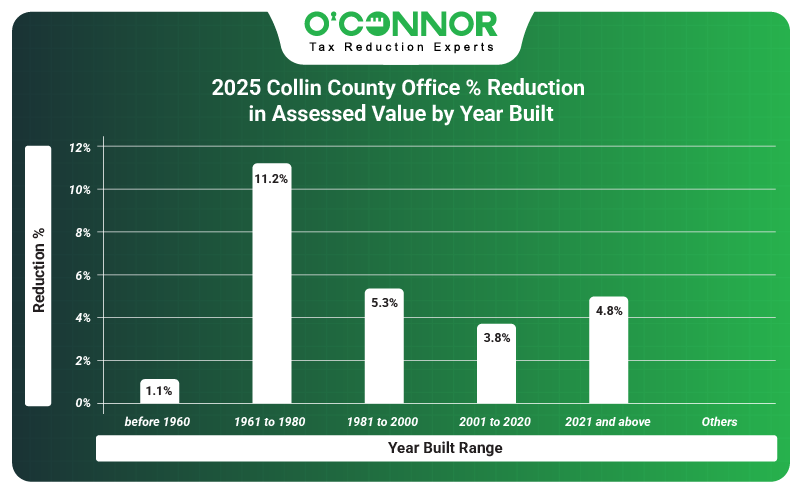
Offices managed to top raw land as the second most valuable commercial property in Collin County. Valued at an estimated $16.34 billion, offices follow the same pattern as other properties when it comes to when they were built. 63% of office value was created between 2001 and 2020, which makes the 3.8% reduction tied to this era key in the overall cutting of taxable value. 27% of office value was built between 1981 and 2000, with this category seeing a value cut of 5.3%. New construction already accounts for 9% of the total and is seeing the fastest rise in value. These recent buildings were reduced by 4.8% thanks to appeals.

Like apartments, all offices are only broken down into two subtypes. $14.84 billion in value was given to generic office buildings, while medical offices received $1.79 billion. The huge office building block managed a reduction of 4.6%, while medical offices got 2.5% stricken from the books.
Collin CountyRetail Protests Answer 16.4% Raise with 4.9% Cuts
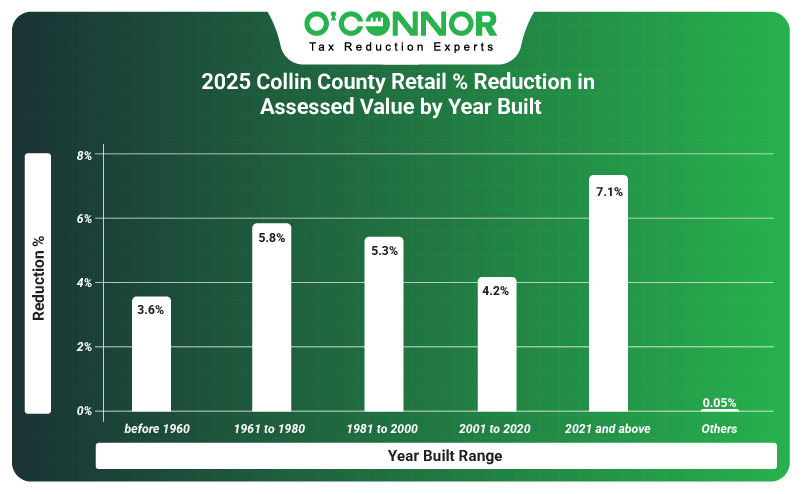
Retail owners got some major sticker shock in 2025 as their taxable value skyrocketed by 16.4%. This was particularly felt by retail buildings constructed between 2001 and 2020, which accounted for 50% of all value in the county. The usual battery of protests ensued, and retail as a whole managed to cut these aggressive values by 4.9%. The aforementioned timeframe got an initial decrease of 4.2%, leading the way. Those built between 1981 and 2000 were the second-largest category and got a solid 5.3% decrease. New construction already makes up 10% of all value and will keep moving up in that regard. New construction secured a drop of 7.1% thanks to appeals.
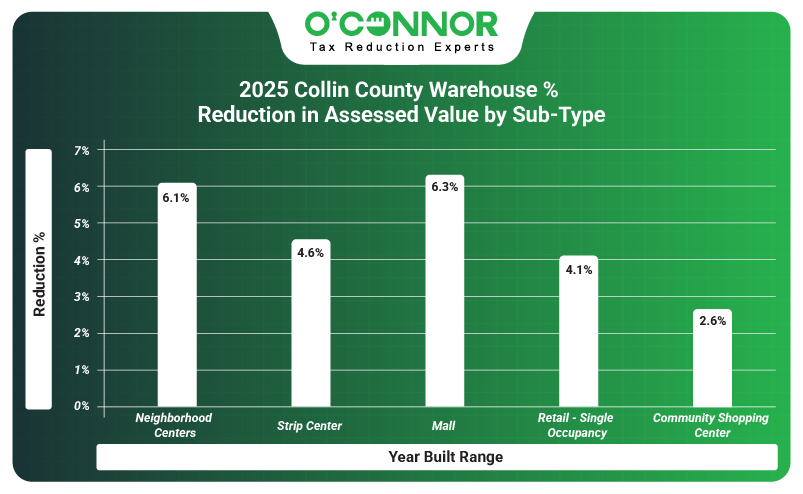
Retail spaces are divided into many subtypes, unlike previous properties. Strip centers were the largest by total value and managed to get a decrease of 4.6% in their taxable value. Neighborhood centers were in the No. 2 slot and scored a solid reduction of 6.1%. While they are the smallest of the subtypes, malls won big with a savings of 6.3%. Single-occupancy retail suffered the largest increase of 2025, a huge 21.5% added to taxable value. These big box stores fought back, reclaiming 4.1% of value thanks to informal appeals.
Collin County Warehouses Trim Value by 3.6%
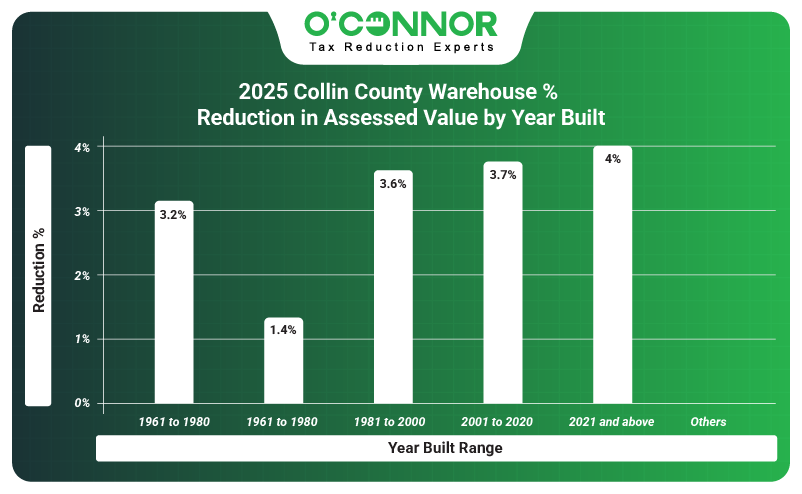
Warehouses are always a reliable source of commercial value in any community and those in Collin County saw their value shoot to the moon thanks to an increase of over 26.6%. This was mostly driven by new construction, which saw a 73.3% increase in taxable value, becoming 21% of all value. New construction received a cut of 4% from appeals, while the warehouse total fell a respectable 3.6%. Warehouses built between 2001 and 2020, the largest pool of value, saw a reduction of 3.7%. The warehouses constructed between 1981 and 2000 were the second-largest holders of value and received a decrease of 3.6%.

CCAD splits warehouses into three categories to help understand how value is generated. Office warehouses are the top dog when it comes to value, totaling $873.70 million. Generic warehouses came in second with $481.09 million, while mini warehouses notched $817,677. Office warehouses and generic warehouses both managed to save 3.6% through property tax appeals, while warehouses saw no statistical reduction.
Collin County is One to Watch
At face value, it appears that Collin County property owners got hit hard by CCAD. While all properties saw impressive savings, these were largely inadequate and did not offset the gigantic increases handed out. However, keep in mind that this is mostly the result of informal appeals. Collin County has long focused on ARB hearings over informal appeals, and this preference becomes stronger every year. Also, Collin County sees a lot more appeals than the average county.
While informal appeals wrapped up in May, ARB hearings will last for months, going until every case is heard. This is when the true effect of appeals will be felt. Much like Travis County, the informal appeals are just a prelude to the real show. And after months of ARB appeals, there is the option to settle things with lawsuits, binding arbitration, or other legal means. These tactics are reserved for high-dollar properties, which includes more of Collin County each year.
If you are struggling with property taxes in Collin County, feel free to reach out to us at O’Connor. We have been fighting Texas property taxes for 50 years and have helped clients across the country get the best results from their property tax protests. If you need help with an ARB hearing or a lawsuit against CCAD, we can help you every step of the way. We will also protest your taxes annually, meaning we will back you in 2026 when it comes to starting everything over again. So, if you missed the deadline, please sign up with us so that you will be ready to secure your property and financial future.

